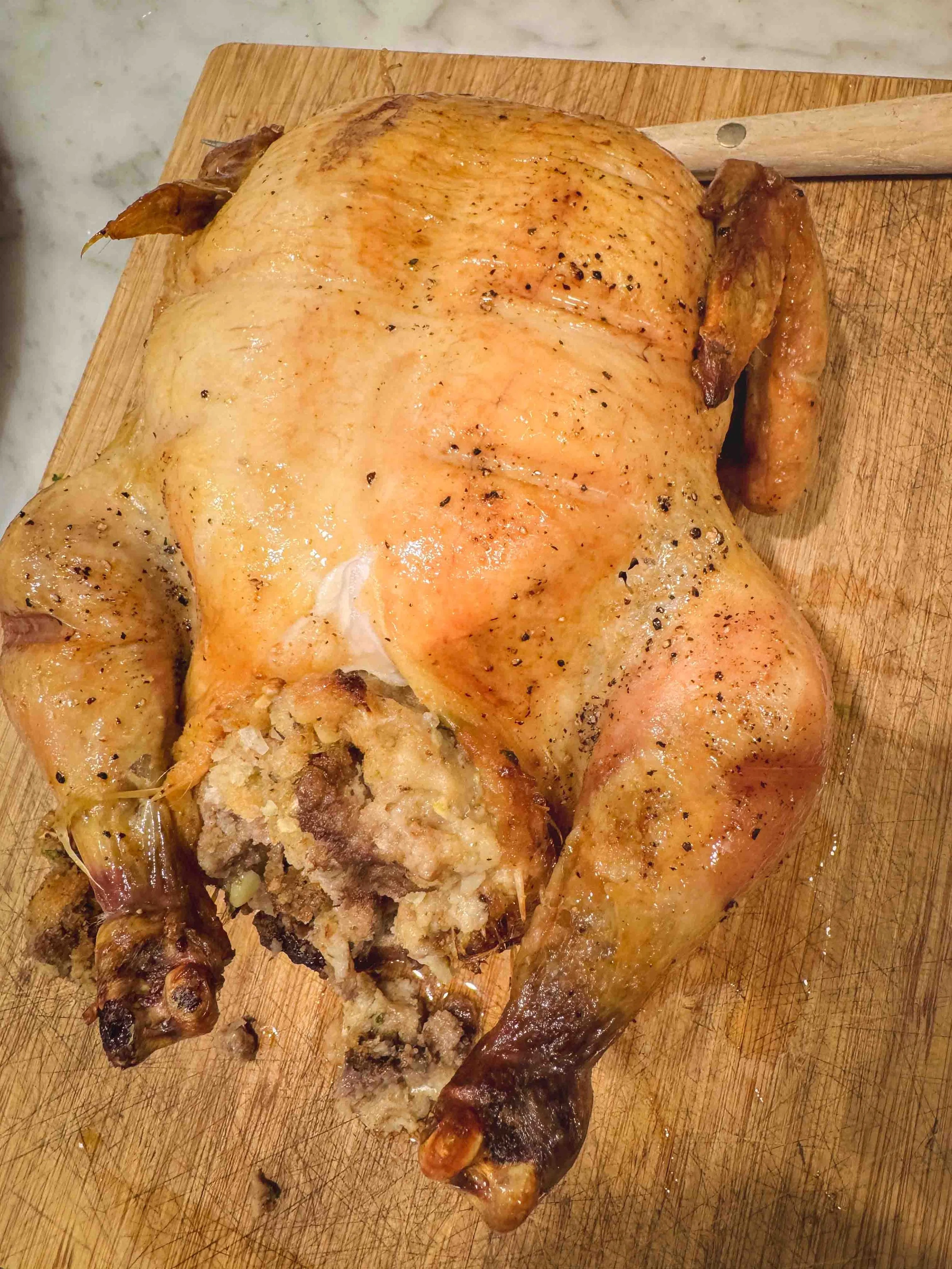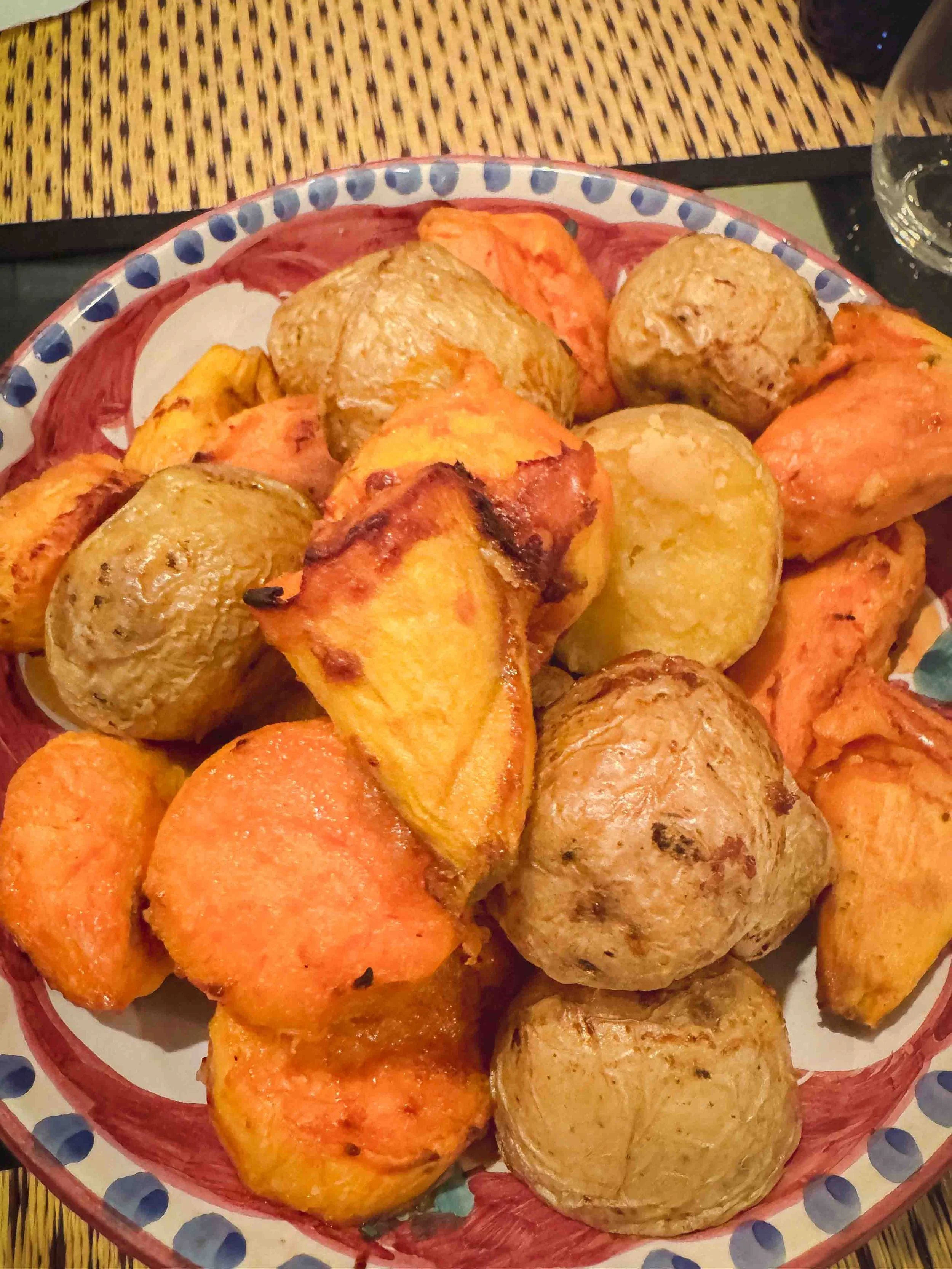Dry-Brined Roast Chicken
Forget about cooking a turkey for Thanksgiving. Let’s face it, it’s a big old boring bird that is dried breast meat drowned in gravy. A chicken is a better choice and far more manageable and tastier. Your best option: try brining it for an extra tasty bird.
But you need to plan ahead. Dry brine (a lot less messy than a wet brine) will cause a chemical reaction. Salt pulls out meat juices through osmosis. Then, the salt dissolves into the juices, turning into a “natural” brine even though there isn't any added liquid. That will ensure the meat is moist if you brine it overnight.
Serves 4-6
Ingredients
- Whole chicken (3-5 lbs.)
- Salt and pepper
- Sweet potatoes
- Roasting potatoes
- Chicken broth
- Flour
- 2 tablespoons of butter
- 2-3 tablespoons of olive oil (extra virgin is the best)
- Chicken stock
Stuffing
- 4-5 cups of breadcrumbs
- 3-4 minced garlic cloves
- 1-2 cups of onion
- Chopped cilantro
Preparation
Carefully rinse the chicken (careful not to spread any raw juice on countertops) and pat it super dry.
Spread 2-3 tablespoons of salt (Kosher is recommended) all over the chicken in the cavity, rubbing it over the surface. Put it on a plate, uncovered, in the refrigerator for 24 hours to brine.
The next day take the chicken out of the refrigerator at least a half hour before cooking.
Prepare the stuffing: mix together bread crumbs (depending on how much will fit in the cavity), a few cloves of chopped garlic, the chopped onion, and some chopped cilantro with some water to soften the crumbs. It should have the consistency of a lump of hamburger meat. Stuff it into the cavity.
Brush the salt off the chicken (some will remain on the bird, that’s ok.) Sprinkle some pepper on the chicken. Using cooking twine, tie the wings together and tie the legs together.
Preheat the oven to 350 degrees Fahrenheit (175 degrees Celcius). The best way to cook a chicken is in a roasting pan with a rack, which lifts the bird off the pan so heat can circulate. Pour some olive oil on the surface of the pan where the potatoes will go.
Peel and cut the potatoes and dust in flour. Place them on the bottom of the pan. Drop the chicken onto the rack and place it in the oven.
Start with it bottom side up and halfway through turn the chicken over so both sides get browned and crisp.
It takes about 20 minutes per lb. to cook. At the halfway point take the chicken out and flip it over. Turn the potatoes at the same time. Raise the oven temperature to 450 degrees Fahrenheit (230 degrees Celcius).
During the second half of the roasting, you need to check the internal temperature of the bird. When it reaches 165 degrees Fahrenheit (75 degrees Celcius), it’s done. And watch the potatoes so they don’t burn. When the chicken is cooked, place it on a platter to rest and use the pan to make the gravy.
First make a roux, made of gravy, butter, and olive oil. Melt butter in a saucepan, then add in the olive oil and flour, and cook the mixture over low heat until it’s thick, brown, and lump-free.
In the roasting pan pour in some broth and scrape all the drippings into the liquid. Slowly add the roux and mix until you have a silky-smooth sauce. If it gets too thick add more chicken stock. Gravy likes a lot of salt so add it to your taste.
Don’t forget your veggies! Green beans go really well with this dish but do you want to just serve boring boiled beans? Instead, check out this recipe from Chef Jean-George Vongerichten. Leave it to him to add some pizzazz to a simple vegetable.
https://cooking.nytimes.com/recipes/1015483-pan-roasted-green-beans-with-golden-almonds
Note: another nice addition is some cranberry sauce (to give it that Thanksgiving vibe). You can use the canned stuff, but it’s nicer to use real cranberries, some orange juice and zest, and some sugar. Grind it up in a blender and serve it cold.
I make this even for two people because it’s one of the few dishes that holds up as leftovers. Heat the meat and potatoes in your toaster oven (or oven) and zap the gravy in the microwave, and in ten minutes, you’ve got a second dinner.


